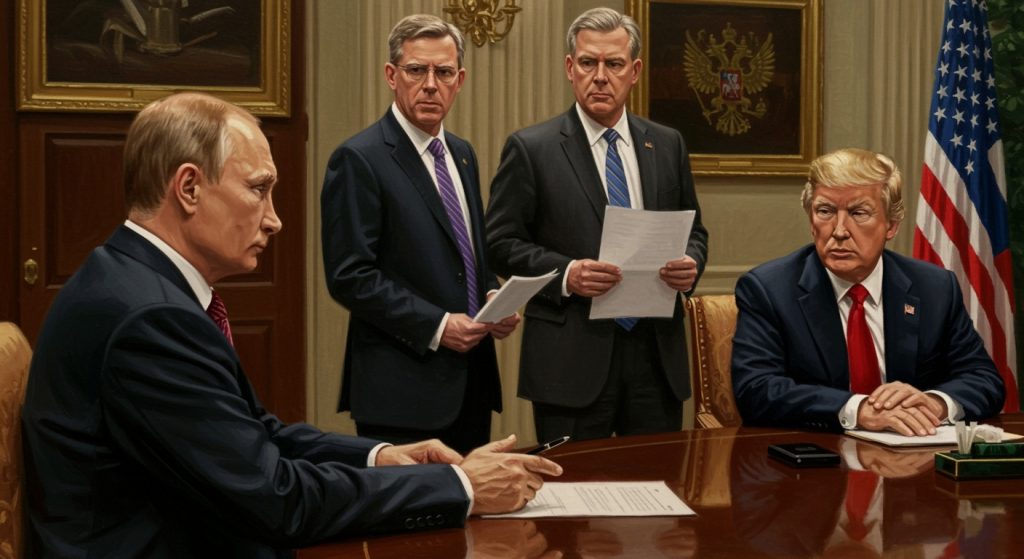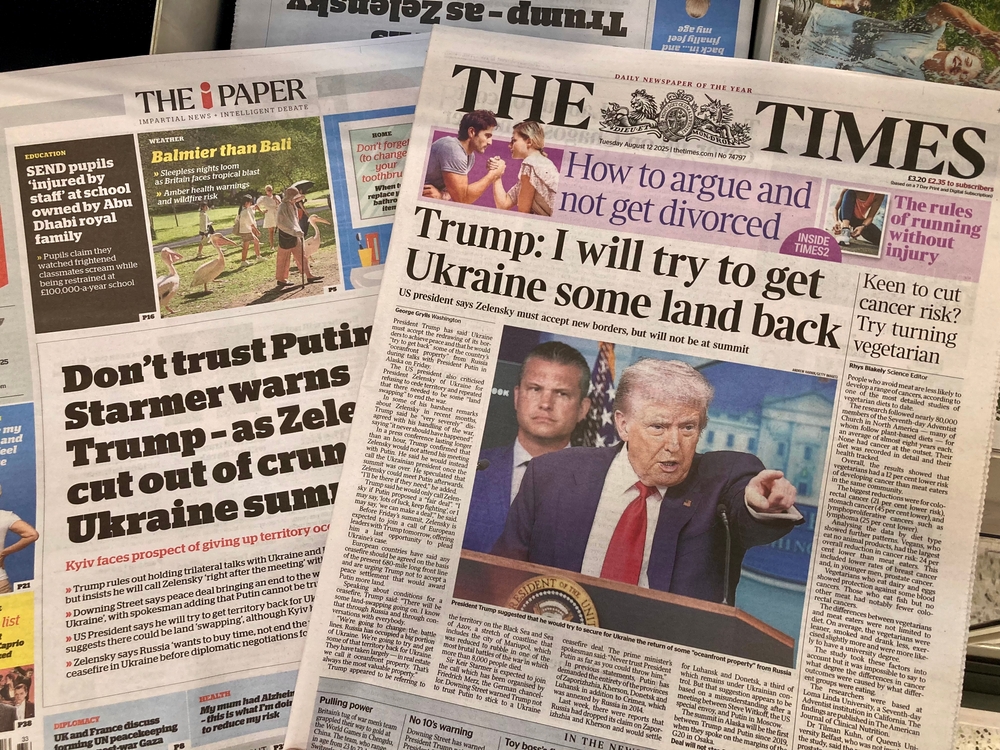Your cart is currently empty!
Sensitive new details revealed after government papers were left behind at Trump-Putin meeting

Sensitive details from the August 15 meeting between former U.S. President Donald Trump and Russian President Vladimir Putin in Anchorage, Alaska, have come to light in an unusual way. While the two leaders spoke privately for three hours and shared only a brief statement with the press afterward, papers later discovered at a downtown hotel revealed additional information about what took place behind closed doors.
According to NPR, eight documents bearing U.S. State Department markings were left in a public printer at the Hotel Captain Cook the morning after the summit. Though officials insisted the papers were not classified, their contents included logistical details, staff names and phone numbers, and carefully prepared seating and dining arrangements. The material provided a rare behind-the-scenes look at how such high-level diplomatic meetings are organized, offering the public a level of insight normally shielded from view.

The Unintended Disclosure
When former U.S. President Donald Trump and Russian President Vladimir Putin met in Anchorage, Alaska, on August 15, the world’s attention was fixed on their rare face-to-face dialogue. The two leaders discussed the possibility of a peace deal amid Russia’s ongoing war in Ukraine. After three hours of private talks, they emerged to deliver a brief, carefully worded 12-minute press conference, noting only that “progress” had been made without offering concrete details.
Yet what was meant to remain behind closed doors may have been partially unveiled in a startlingly mundane way. According to NPR, eight papers bearing U.S. State Department markings were discovered in the business center of an Alaskan hotel the morning after the summit. Guests at the Hotel Captain Cook reportedly stumbled upon the documents left in a public printer and later shared images of the pages anonymously with the outlet.
The papers, which officials insist were not classified, appear to contain sensitive logistical information: exact meeting times and locations, the names and contact details of U.S. staff, as well as lists of Russian officials slated to attend. One page even noted the intended diplomatic gift from Trump to Putin—an American bald eagle desk statue. Other pages reportedly included seating arrangements for a planned luncheon, complete with detailed menus and the positioning of top U.S. officials such as Secretary of State Marco Rubio and Secretary of Defense Pete Hegseth alongside their Russian counterparts. Though the lunch was ultimately cancelled, its planned menu—salad, filet mignon, halibut Olympia, and crème brûlée—was carefully outlined.
While the White House dismissed the matter as little more than a “multi-page lunch menu,” the papers nonetheless raise questions about how closely guarded details of such high-stakes diplomacy came to be left behind in a hotel printer.
The Contents of the Forgotten Papers
The documents left behind at the Hotel Captain Cook shed light on aspects of the Trump-Putin summit that had not been made public. According to reporting by NPR, the papers included several categories of information:
- Logistical Details: Pages described exact meeting times and locations within the Anchorage venue, along with the names of the specific rooms used during the summit. This level of planning is standard in high-level diplomacy but is rarely shared outside official circles.
- Staff and Attendee Lists: Among the most striking revelations were the names and contact numbers of three U.S. staff members, along with a list of 13 American state leaders and their Russian counterparts. The documents also included a guide to pronouncing the names of Russian officials—a small but telling glimpse into how American aides prepared for the encounter.
- Gift and Symbolism: One page noted that Donald Trump planned to present Vladimir Putin with an “American Bald Eagle Desk Statue,” a gesture that blended symbolism with diplomacy. Such gifts are typically carefully chosen to reflect national identity or shared values, though in this case, the detail emerged through unintended disclosure.
- Luncheon Plans: Perhaps the most colorful portion of the papers was the section outlining a formal lunch that was to be held “in honor of his excellency Vladimir Putin.” Seating charts positioned Trump alongside senior members of his cabinet—Secretary of State Marco Rubio, Secretary of Defense Pete Hegseth, Chief of Staff Susie Wiles, Treasury Secretary Scott Bessent, Commerce Secretary Howard Lutnick, and Special Envoy Steve Witkoff. Putin, in turn, was to be flanked by Foreign Minister Sergey Lavrov and foreign policy aide Yuri Ushakov. The menu listed a classic diplomatic spread: salad, filet mignon, halibut Olympia, and crème brûlée. Although the lunch was ultimately cancelled, the planned arrangements demonstrate the degree of detail that goes into such encounters.
While the White House later dismissed the cache as “a multi-page lunch menu,” the papers clearly contained more than meal options. Taken together, they offered a rare behind-the-scenes look at the mechanics of an international summit normally hidden from public view.

How the Papers Were Discovered
The discovery of the papers was as unexpected as it was concerning. On the morning after the Trump-Putin meeting, three guests at the Hotel Captain Cook in Anchorage came across documents that had been left in a public printer in the hotel’s business center. According to NPR, the guests photographed the documents and later shared them with the outlet on the condition of anonymity.
The papers bore markings from the U.S. State Department, indicating they had been produced by government staff involved in preparing the summit. They were not classified, but they contained information not intended for public release, including the internal logistics of the meeting and details about the officials present. The fact that such material ended up unattended in a hotel printer rather than secured in official channels raised questions about how tightly summit operations were managed.
Officials attempted to downplay the matter. White House Deputy Press Secretary Anna Kelly dismissed the documents as little more than a “multi-page lunch menu,” a characterization that sharply contrasted with the breadth of information actually revealed. Nonetheless, the acknowledgment that U.S. government paperwork had been left behind in a public setting fueled interest in how it happened and whether safeguards had failed.

The Officials Involved
The documents did more than list events and menus; they also highlighted the key figures from both the American and Russian delegations. For the U.S., the seating chart positioned Donald Trump alongside senior members of his team: Secretary of State Marco Rubio, Secretary of Defense Pete Hegseth, Chief of Staff Susie Wiles, Treasury Secretary Scott Bessent, Commerce Secretary Howard Lutnick, and Special Envoy for Peace Missions Steve Witkoff. Their inclusion signaled which officials were expected to play central roles in discussions.
From Russia’s side, the documents showed Putin’s close circle of advisors, including Foreign Minister Sergey Lavrov and Yuri Ushakov, his top aide on foreign policy. These names aligned with longstanding Russian diplomatic structures, but the lists also served as a guide for U.S. staff, complete with pronunciation notes. This detail illustrates the extent of preparation required to navigate formal interactions between two leaders whose relationship has often been scrutinized for its unpredictability.
The revelation of these lists in a public setting—however briefly—provided an unusually candid look at the human infrastructure behind a major diplomatic meeting. While such details might appear mundane, they underscore how carefully choreographed international summits are, with every name, seat, and symbol carrying potential weight.
The Meeting Itself
The summit took place on August 15 in Anchorage, Alaska, a setting that drew global attention as Trump and Putin arrived by jet and stepped onto the red carpet. Their handshake was described as firm and slightly forceful, with Trump notably pulling Putin closer in a moment captured by the press.
Behind closed doors, the two leaders engaged in three hours of talks centered on the possibility of a peace deal amid Russia’s war in Ukraine. Both leaders emerged later to deliver a brief, 12-minute press conference in which they stated no resolution had been reached but noted that “progress” had been made. The brevity of the public remarks stood in contrast to the length of the private meeting, leaving analysts and the public alike curious about what had transpired.
Until the discovery of the papers, the inner workings of the summit had remained largely concealed. The documents, while not revealing substantive negotiation details, nonetheless painted a picture of the logistical and symbolic elements shaping the encounter—details that often influence the atmosphere of talks as much as the words exchanged at the table.
Broader Questions Raised
The accidental release of summit materials invites broader questions about the handling of sensitive information in high-stakes diplomacy. Even though the papers were not classified, they revealed details that governments typically safeguard, from staff contact numbers to the intended flow of events. Such information, in the wrong hands, could be used to disrupt or undermine diplomatic efforts.
Moreover, the episode highlighted how fragile the control of information can be, even in meticulously managed environments. That official documents tied to a major international meeting could be left in a hotel printer underscores how human error continues to challenge systems of security. For observers, it is not just the content of the papers but the lapse itself that stands out, suggesting vulnerabilities that extend beyond the specifics of this single meeting.
What the Documents Ultimately Revealed
Although the forgotten papers did not expose classified material, they revealed a surprising amount about the behind-the-scenes planning of the Trump-Putin summit. The documents detailed the exact rooms and times of meetings, contact information for American staff, and comprehensive lists of Russian officials in attendance. They also showed the extent of preparation involved, from pronunciation guides for Russian names to the symbolic choice of a bald eagle statue as a gift.
The seating charts and lunch menu added another layer of insight, highlighting which American officials were positioned closest to the former president and which Russian figures were expected to sit at Putin’s side. Even though the lunch was cancelled, the careful planning illustrates how much attention is given to protocol in such encounters.
In the end, what was left in a hotel printer offered the public an unusual glimpse into the mechanics of a high-level diplomatic meeting—details that would otherwise never have been seen outside official circles.
